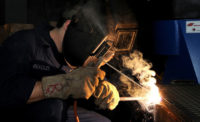Industry 4.0 has arrived, which means machine shop owners and managers of large manufacturing concerns are all looking at their options for bringing about their own transformation. But what functionality does smart factory equipment really offer? And what types of equipment are worth the price of adoption? Let’s take a look at some developments that are improving manufacturing permanently, and for the better.
Artificial intelligence & machine vision
Manufacturing hardware is only as intelligent as the software powering it. AI is set to become one of the most important competitive assets in manufacturing. But what does it look like, actually put into practice? Machine vision is one of the best examples.
When it comes to inspecting the smallest details of high-value (and high-risk) merchandise like circuit boards and computer chips, the human eye is fallible. Thanks to artificial intelligence, high-resolution cameras installed along an assembly line or in a designated inspection point can spot even tiny defects1 and check them against known parameters, all without (or with limited) human intervention. And since it’s part of a larger network of connected sensors, workstations and data-gathering implements, these defects get flagged and kicked out of the line immediately, and the problem is traced to its source.
Connected sensors & proactive maintenance
Of course, it’s always better to spot potential breakdowns and machine damage that might cause defects before the machine starts churning out duds, if you can help it.
Which kinds of manufacturing or material handling equipment do you rely on? You may have a series of conveyor belts, pallet trucks, mechanical arms, CNC machines and even 3D printers. There are lots of moving parts and critical components here, any one of which could bring your operation to a halt. But with connected sensors deployed along a conveyor belt, or embedded inside machines on the assembly floor, engineers and maintenance personnel can receive readings for any number of variables, like machine temperature, energy use, vibration and even moisture, and of which could indicate an impending problem that could threaten your workflow and livelihood. It’s hard to put a price tag on this kind of advance warning.
Generative design & rapid prototyping
One major pressure within the manufacturing industry involves turning out and testing a series of prototypes in quick succession. The design and testing phases need to happen fast enough so companies can reach the market in a timely fashion, but not so fast that the organization doesn’t have time to test the most promising designs or work out all of the potential kinks.
Generative design is not a new concept, but technology today makes it more accessible to a wider variety of manufacturers. Generative design involves the use of artificial intelligence to automatically generate part and product designs based on a limited set of user-defined requirements, such as the quantity of raw material to be used, final price, structural strength, and other tolerances or characteristics.
This type of computer-aided design is brought to completion by additive manufacturing. Once an engineer has several prototypes, dozens even, that satisfy the basic requirements, 3D printers spring into motion to perform rapid prototyping.
Facility management & waste reduction
Manufacturing plants rely on oftentimes massive quantities of raw materials which must be kept in stable and workable condition. In plants that work with steel, for instance, IoT implementations can help reduce instances of “mill scale,” a flaky buildup on the outer layer of steel that makes it difficult or impossible to work with without additional treatment. But, by using connected sensors and an IoT platform powered by Intel processors, some manufacturers have learned to predict mill scale with at least 78% accuracy2. This cuts down on wasted materials by up to 15% and reduces the need for ferroalloys, which are expensive.
Wasted materials are an unnecessary expense for companies, but duplicated effort and squandered resources mean the health of the planet takes a hit, too. Even in manufacturing environments where “dirty” energies are still in use, such as where generators, vehicles, ships, aircraft and other vehicles make use of gas turbines, sensors coupled with AI can help make on-the-fly changes, like fuel valve adjustments, to make sure not a single drop of fuel is wasted and emissions remain as low as possible3. This isn’t just important for a clean conscience — maintaining a mindfulness (not to mention a paper trail) of a company’s emissions is frequently a matter of compliance with local or federal regulations.
Retrofit or upgrade?
As we close, it’s worth discussing the fact that shop owners can choose to retrofit existing equipment instead of buying new. The truth is, there are many “on ramps” when it comes to buying into the Industrial IoT.
According to a survey, some 58% of manufacturing sector representatives indicated they were interested in bringing artificial intelligence and other disruptive technologies into their workplaces. And yet, only 12% said they had plans4 in motion to adopt it.
The good news is, the accessibility of the IoT is increasing practically by the day. That includes the selection of aftermarket kits for manufacturing and material handling equipment, industrial vehicles, and physical infrastructure is giving companies lots of options that don’t involve bringing brand-new equipment aboard. Whether your goal is to add condition monitoring and analytics to legacy assembly equipment or bring visibility into the supply chain with sensors, there’s likely an option out there. And if you’re due for an upgrade after all, know that this is a great time to get your foot in the “Industry 4.0” door.
Sources
- https://www.forbes.com/sites/insights-intelai/2018/07/17/how-ai-builds-a-better-manufacturing-process/#222303321e84
- https://www.intel.co.uk/content/www/uk/en/manufacturing/article/factories-improve-uptime.html
- https://emerj.com/ai-sector-overviews/machine-learning-in-manufacturing/
- https://www.themanufacturer.com/articles/power-artificial-intelligence-manufacturing/
- https://www.networkworld.com/article/3321018/how-to-add-iot-functions-to-legacy-equipment.html



